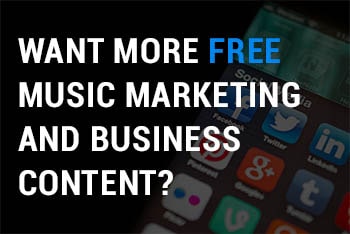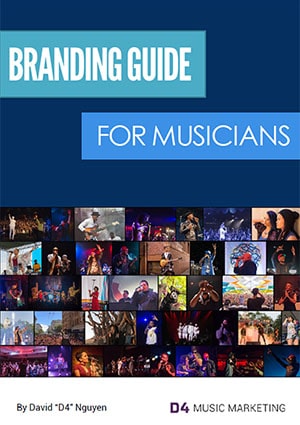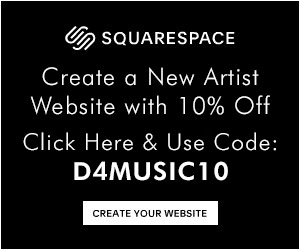
Last Updated: 4/28/25
As you can imagine, this is a very popular question I get from aspiring and emerging artists. It always revolves around marketing music without a budget.
“How do I start a career with no money?”
“How do I market my music with little to no budget”
“How do I promote my songs if I’m broke?”
For so long, I’ve avoided answering this question directly because I didn’t want to support this idea that you can build a sustainable music career by depending on free or cheap options. But then I realized that I’ve indirectly answered this question throughout multiple blogs so I decided to put it all together in one resource.
In this blog, I will cover budget-friendly ways to tackle the different areas of music marketing. It’s important to understand that marketing encompasses more than just music promotion to reach new potential fans. It also involves other things like how to maintain relationships with your current fans, staying top of mind with different touch points, accessing data to make better business decisions and having products to sell them.
Please Note: This blog contains affiliate links to products and services I personally use and recommend. Using these links helps to support my work at no extra cost to you. Read my full disclosure on all the companies I’ve partnered up with here. For full transparency, I will label any affiliate links so you know.
Music Distribution
When you’re just starting out, you can get away with uploading your music on free platforms like SoundCloud, YouTube, BandCamp and AudioMack in the short term. This is especially true if you’re starting music out as a hobby and having fun with it.
The problem is these aren’t usually the go-to places to listen to and discover music (with the exception of YouTube) if you want to take music to the next level.
Eventually, you’ll want to get your music on digital service providers (DSPs) like Spotify, Apple Music and Amazon Music. As an independent, you’ll have to go through a music aggregator like DistroKid (Affiliate) or CD Baby to do that, but it’s relatively inexpensive depending on what service you go with.
You may want to consider using some free music distribution options. TuneCore has a free plan that allows you to upload unlimited music to the top social platforms (TikTok, Facebook, Instagram, YouTube) but they take a 20% cut of your royalties.
RouteNote offers a free plan where you can uploaded unlimited music to all the top DSPs and take 15% of of your royalties you earn through them.
The company I personally use with my clients and recommend only be as low as $23 a year. Read my breakdown on what I think is the best music distribution for independent artists.
Website
Some may say it’s debatable, but I’m a big believer that independent artists need to have a website if they want to be a professional. It doesn’t mean you need to have one right away, but at some point, you want to have online real estate that you own and control. it’s something you The main benefits of having your own personal website:
- You can set up an online shop to sell your music and merch directly to fans without a middleman taking their cut.
- Establish your own personal online space where you can control your story while actually owning the property. Remember your social media accounts are on rented land; you don’t actually own your followers and your profile.
- Create a landing page to drive traffic from your social media ads. This way you have a place to market new potential fans and further develop your relationships with them.
As someone new to the music business, you can hold off in the short term since it can be a bigger expense. There are a bunch of different website platforms to choose from, but it can range from $100 to $300 a year. On top of that, if you don’t design it yourself, it can cost hundreds of dollars more depending on who you have doing it for you.
If you’re looking for free options, Wix and Weebly offer free plans for you to try out. However, I highly recommend not using them as a long-term solution. You can read more about my thoughts about them and the drawbacks they present here.
Although I’ve created over 50 websites on WordPress, my personal favorite website building platform right now is Squarespace (Affiliate). I have partnered up with them to offer you 10% off your first-year subscription if you click this link and use the coupon code D4MUSIC10 when you check out.
For example, I’ve recently built this website for Rocky Rivera using Squarespace.
If you do decide to create one yourself, you’ll want to incorporate these 11 things into your musician website.
In the mean time, you can get away with you using a micro website or a “link in bio” page instead of a full website. Linktree is a popular option, but the one I like best is Beacons. Not only does it look better to me, but it also offers more features and tools with the free plan. I personally use it myself.
Target Audience
You can’t market effectively without defining a target audience. Who are the types of people most likely to become fans of your music and how do you go about reaching them? This is all needed to help guide your strategy and build a foundation for your music career.
There’s not necessarily a tool or service that you need to figure this out, but more so a strategy or mindset. What I like to say is you need to niche down and build within a community. I wrote a very detailed blog on this that you can read here.
Once you have an audience, the next step is knowing how to reach them. If you have the budget, I’m a big advocate of paying up for Facebook, Instagram and YouTube Ads. Just be warned that it’s easy to waste money if you don’t know what you’re doing or if you’re music isn’t good enough to be marketed yet.
Email Marketing
You’ll often hear that having an email list is essential for your music business. Emailing fans is a more effective way of maintaining a direct relationship with them compared to something like social media.
Email marketing services can be pricey, but Mailchimp is actually free. Even though features are limited in their free plan, you can still build a list of up to 500 email subscribers without paying a cent. My biggest issue with Mailchimp is that they’re expensive if you have a lot more email subscribers. It can cost almost $60 a month with around 2,500 subscribers. I know an artist who was paying $250 a month because they had a ton of email subscribers.
I started using ConvertKit (Affiliate) recently and it is another great option. They recently increased the number of subscribers allowed in their free plan to 1,000 subscribers. I don’t have as much experience with them compared to MailChimp, but I do like that they are moving more towards the music space with their latest acquisition of FanBridge, an email marketing service for musicians.
These are both excellent free options when you want to limit your expenses earlier on in your career.
Bandsintown has a free email marketing service currently in beta. This could be something worth checking out.
The best budget friendly option right now is using Beacon’s email broadcast tool. I’ve already converted a few of the artists I work with to Beacons because it’s just more affordable once you hit a certain number of email subscribers. For unlimited email sends and a bunch of other features, it cost $25 a month paid annually.
Content
Whether you like it or not, you’ll need content as a tool to promote yourself and your music. This is often the biggest challenge for artists, at least being able to create and put it out consistently. It’s important to understand that content marketing is arguably the most effective and scalable form of marketing.
Photos
You definitely need high-quality photos to use in your promotion like social media posts, websites, EPK (Electronic Press Kit), online profiles, covert art and more. For some things, you may be able to get away with using a newer smartphone as long as you have the right lighting.
There’s a good chance you may know a photographer that may be able to do stuff for free or cut you a deal. Ask people you know within your network for recommendations.
Videos
When it comes to marketing yourself and your music, the most important type of content is video. You don’t need to pour your life savings into one high production video, but some moving picture with your music in it will do.
Here are some video content ideas that don’t need big budgets. You may be able to do it yourself with some simple video editing and maybe another person to help out with the recording. It is entirely possible to produce quality video content that can go viral using your smartphone and free video editing tools available.
Short-Form Video – This type of video has become increasingly popular with the rise of TikTok over the years. Because it’s shorter and easier to digest, it’s the ideal way to market yourself and your music on social media. Read more about how to get started with my dedicated blog on short-form video, specially revolving around performance of a song. You can also learn a lot from an album campaign release using them.
Green Screen – Perform your song using a green screen as a backdrop so you can change the background to anything you want. Here is a video using a green screen that I edited. Instead of different scenery, I used different solid colors for each element of the song:
Lyric Videos – Another low-budget option is doing a lyric video for one of your songs. You’re basically overlaying your lyrics with the song over some stock footage or B-roll video. Here’s an example of a lyric video that uses b-roll footage:
You can also do an animated lyric video. If you’re not good with video editing, you can find some budget-friendly options over on the popular freelance marketplace Fiverr. They are an affiliate so please read my full disclosure to learn more about what that means.
Live Performance Video – For these types of videos, it doesn’t exactly have to be “live” but it should look like you are. It can be recorded someplace in your home or somewhere outside for a nice backdrop. If you are filming outside, be careful with where you go because some places don’t allow you to record without a permit or permission. For example, national parks. Here are some examples of videos I’ve shot and edited:
Music Visualizers – Maybe for whatever reason, you weren’t able to record a video for your release. One option is to make a music visualizer around your cover art. If you use DistroKid (Affiliate) to distribute your music, you can actually create a free, short mini video to use on social media. You can also pay for them to generate a music video visualizer for the full song as well.
The key to good content is something that is shareable so make sure whatever platform you’re on, that others are able to share it. This means not having a private profile or account.
Playlisting
One of the best free playlisting opportunities for your upcoming releases is to submit your song to be considered on Spotify’s editorial playlists and Amazon Music’s curated playlists. Getting on one of these playlists won’t make you a global superstar overnight, but it’ll give you a nice little boost of momentum. It isn’t easy to get placed, but it’s worth a short for something that is free.
Another free tool you can use is Playlister by DistroKid. It’s currently in beta as of this writing, so you’ll need to enter the password “gravy” to use it. This tool allows you to get contact information from Spotify playlisters based on any genre or keywords you provide. Because Spotify does not provide a way to reach out to playlist owners, it can be a challenge to pitch your songs. With Playlister, this process is much easier to pitch your songs.
For more on Spotify playlists, check out my guide here.
Music Blogs
Another route for marketing your music on a budget is pitching your songs to independent music blogs. A publicist can cost a lot of money so it’s a great starting point if you don’t quite have the funds and video content to use in Facebook, Instagram or YouTube ads. Just keep expectations in check as music blogs just don’t have the same influence they used to before social media dominated online attention.
A popular tool to help with not only pitch to music blogs, but also playlists and influencers, is SubmitHub. They do have free submissions you can choose from, but I feel it’s not worth your time. It’s cheap so I’d recommend paying up to $30 or so in credits to submit to their premium blogs.
Another similar tool to consider is Groover. They are based in France, but you can reach bloggers from all around the world. I personally have not used them yet, but they look to have a lot of the same blogs and similar pricing to SubmitHub.
Lastly, I put together a list of 44 blogs where you can submit your music for free, a lot of which accept submissions through SubmitHub.
Merch
We all know that there’s very little money to be made from marketing and promoting your actual music in this streaming age. The real money, aside from performing at live shows, is selling merch like tees, hats and posters.
Merch can also consist of selling CDs of your albums as fans still like having something physical to take home as a memento or collect. This still has good profit margins, but the demand for them isn’t what it was pre-streaming.
If you’re a relatively new artist, you’re probably not going to want to sink money into getting CDs or vinyl pressed up (definitely not vinyl as it’s expensive). That’s an investment you’ll want to hold off on, but there are ways to make money selling physical products without money upfront. This is where print-on-demand comes in.
Print-on-demand (dropshipping) services like Printful (Affiliate) allow you to design products to sell and will handle everything from production to fulfillment. You don’t have to do any work other than promoting the products on your website. There are no fees or costs on your end. You only make a profit for items you sell. To learn more, I cover this topic in-depth here.
What should you make and what kind of designs should you use? For that, you need to know who your target audience is and how your brand reflects that. This blog I wrote will help you to determine what merch you should be making as a musician.
Graphics, Logos, Cover Art
An important factor in music marketing and branding is the visual component. Not everyone can afford a graphic designer or access paid software like Adobe Photoshop. There are free or cheaper Photoshop alternatives you can try if you want to attempt creating them yourself.
If money is tight, one of the best options to help you with graphics is Canva (Affiliate). It’s a free, user-friendly app to create a wide variety of graphics from templates. For example, I did a whole blog on creating free cover art for your next release using Canva.
There are a lot of bonuses and features that come with their paid plans, but the free plan allows you to do most things you’ll need without having to pay.
Branding
Good brands are memorable and carry a positive reputation to the ideal people they are trying to reach. This is why understanding branding is massively important to your success as an artist.
Yes, you need good music, but you also need to make sure your presentation and content stick in the minds of your ideal fans. You want fans to emotionally latch to who you are and what you stand for so they are willing to financially invest in you.
Branding can be a confusing topic for many artists. The good news is I have a free branding guide for musicians that you can use to help you figure this out.
Music Promotion
Releasing music can be a tedious process. There’s a lot that goes into the planning and strategy, so I actually put together a very detailed release checklist for independent artists. This will ultimately save you a lot of time, and money, by allowing you to focus on the right tasks rather than wondering what you should be doing.
When it comes down to the actual promotion of your music, there are good and bad ways to go about it. A very useful tool for promoting your music are smart links. Assuming you’ve paid a music aggregator or distributor to upload your music on major streaming platforms, this is a great way to share your music. I covered a bunch of free options for you in this blog here.
As for running social media ads, there aren’t any free options as you will obviously need a budget to run them. But, in this video below, I break down when you may want to consider running Meta or TikTok ads when promoting your music:
Analytics / Insights
Data is power. Having good data to have for your analytics helps with making better business decisions in your music career. As a musician, you have free access to a lot of this information on the various platforms you’re likely on already.
You can learn information about your social media posts, the type of people who engage with your content, what are the top cities your fans are in, your best performing music and much more.
TIkTok
Google Analytics – This is installed on your website. Many popular website platforms will provide you with some website traffic analytics of their own, but Google Analytics is more powerful. It may be too complex for non-tech savvy musicians, but it’s good to add to your website to collect data over time for someone else to review.
Other Free Tools and Apps
Outside of marketing and promotion, you’ll need other free tools to help with your day-to-day tasks. Thankfully, our smartphones allow us to stay productive while on the go. I compiled a list of free mobile apps that can be useful for musicians.
Have you considered leveraging the power of artificial intelligence? With the rise of AI, more powerful tools are becoming accessible to the public that can help musicians in areas like business-related writing, song lyrics, music production, graphics and video content. Check out my beginner’s guide to AI for musicians to see a list of 25+ AI tools to try out. Many of them are free or inexpensive.
Conclusion
Hopefully, this blog has helped put the pieces together for you and pointed you in the right direction about marketing your music with little to no budget required. There’s a lot that goes into marketing and not every area is going to be your priority. You don’t need to have everything done and in place right away.
The last bit of advice I want to end with is this, which touches on another question I get a lot. Of course, I’ve already written a whole blog on what you should know about starting a career in music, but many have asked me, how should I actually start?
Your priority is to set some kind of foundation for your online presence, which usually entails optimizing your social media profiles. Focus on posting video content, whether that’s writing original music, recording performance videos, doing covers or fun videos on TikTok. Most importantly, treat it like a hobby first and have fun with it.
Hold off on thinking about monetization and focus on building an audience through your content organically. Don’t completely neglect how you might want to monetize, but don’t fixate on making money so much that you become impatient.
While doing all of that, you want to dedicate a lot of time putting yourself out there and meeting people. With your niche and target audience in mind, use a community-orientated approach to grow your network. This can be done online too, but I think it’s best to do this in real life and with real people in your city.







